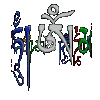 |
Mahayana Buddhist Books |
 |
 |
Although
the book is geared toward scholarly readers, it uses a limited amount of
jargon and carefully explains the background of all of the texts provided,
making it accessible to any reader with an interest in this subject. Despite
the popularity of Nepal as a destination for tourists, the religions of
Nepal are very poorly understood by most Westerners. This book, by
presenting texts which are actually popular among modern Newer Buddhists
gives an excellent feeling for how the religion is understood by the people
who live and practice it. On the more scholarly side, his discussion of the
"domestication" of texts and the role of stories and ritual in culture is
insightful, though there is clearly room for his argument to be taken
further.
Read more |
|
 |
This classic text was written
for those who wish to cultivate bodhicitta (compassion). The great path
of awakening is a commentary of an earlier text The Seven Points of mind
training by Chekawa Yeshe Dorje.
The development of compassion toward all sentient beings is an integral part of the Mahayana path along with meditation and yidam practice, with a goal to fully realize our Buddha nature. In the mean time, the cultivation of compassion will quite the mind, relinquish ego clinging and make us nicer people to know. The text is easy to digest
and the points are easy to put into practice. In practice, for the
novice, Bodhicitta is hard to cultivate and requires diligence and
discipline in ones practice. |
|
 |
The present translation of D.T.
Suzuki is based upon the Sanskrit edition of Bunyu Nanjo (1923). This
edition reflects those fundamental themes of Buddhism which the Mahayana
in general cherishes and upholds. It looks at existence from the
absolute and relative realms, and thinks that suffering will be
experienced so long as one confines oneself to the realm of the
relative. Since the relative cannot be ultimately realm, it has to be
seen as nothing more than a projection of the mind. As to how to realize
the ultimate truth of unity the text resorts to general Mahayana theory
of Buddha logy in which the Buddha is seen as the ultimate ontological
principle.
In order to realize unity
with this ontic principle, we have to make use of such methods which,
though relative, terminate in the realization of Enlightenment. These
methods are spoken of as Skilful Means. As a spiritual manual, the text
points out as to how the Bodhisattvas, on account of their unlimited
compassion for sentient beings, work for the salvation of all. While
delineating on the theme of Bodhisattvas, the text thereby speaks about
the ten vows of a Bodhisattva. It is in incarnating these vows within
that a real turn-about or spiritual transformation occurs, and thereby
are uprooted the roots of ignorance. The text, thus, offers a spiritual
banquet to those who want to taste the bliss eternal. |
|
 |
"Teachings on Love" helps water
those seeds of love in your heart. Here one of the parts I liked the
most:
"Look into the eyes of your beloved and ask deeply, "Who are you, my love, who has come to me and taken my suffering as your suffering, my happiness as your happiness, my life and death as your life and death? Who are you whose self has become my self? Why aren't you a dewdrop, a butterfly, a bird, a pine tree? Ask with your whole body and mind. Later, you will have to ask the person who causes you the most suffering the same questions...To understand, you have to become one with your beloved, and also one with your so-called enemy. You have to worry about what they worry about, suffer their suffering, appreciate what they appreciate. You and the object of your love cannot be two. They are as much you as you are yourself...See and listen with the whole of your being. If you are fully present, the rain of the Dharma will water the deepest seeds in your store consciousness, and tomorrow, while you are washing the dishes or looking at the blue sky, that seed will spring forth, and love and understanding will appear as a beautiful flower." Beautiful isn't it? Now I
must go, I need to begin my practice...
Read more |
|
 |
This is an interesting
commentary and translation of several key pieces of early Buddhist
literature on women and their various roles in society. Paul organizes
the book around several key types, such as "Temptress", "Mother", and
"Nun". Each translation is preceded by a very useful "introduction"
which explains the context of the piece that follows as well as
providing some interpretation. This book is not for those interested in
exploring the lives of contemporary Buddhist women, but rather provides
for those interested in such things, an interesting analysis of ancient
texts that relate to women.
Read more |
|
 |
This is a "can't stop reading"
book. I have read Thich Nhat Hanh books before but this book is my
favorite until now. Every page is filled with compelling teachings of
Buddhism and beautiful thoughts. The book is a love story in which,
Hanh basically combines the teachings of Buddha with the story of his
first love. While reading this book you feel the love in the air and
become totally happy. Don't believe me, find out for yourself. Read more |
|
 |
Buddha
Nature: The Mahayana Uttaratantra Shastra With Commentary is an impressively
presented, highly recommended contribution to the rapidly growing library of
Buddhist studies literature available to the western reader. Enhanced with
exceptional and informative commentary by Jamgon Kongtrul Lodro Thaye, and
with additional explanations by Khenpo Tsultrim Gyamtso Rinpoche, Buddha
Nature is one of the finest, most accessible presentations on the basis and
process of enlightenment with the Buddhism. A seminal, benchmark
publication, no dedicated student of Buddhist enlightenment can omit a
careful and reflective reading of Buddha Nature.
Read more |
|
 |
Ably translated and edited for a
western readership by Jeffrey Hopkins, Kensur Lekden's Meditations Of A
Tibetan Tantric Abbot: The Main Practices Of The Mahayana Buddhist Path
describes in detail the attitudes cultivated in meditation as
experienced by practitioners of the Mahayana Buddhist Path. Readers will
be treated to Kensur Lekden's blend of compassion, wisdom and wit on a
variety of issues ranging from turning away from cyclic existence to
developing love and compassion for all beings, to understanding the
profound view of emptiness. Meditations Of A Tibetan Tantric Abbot is a
welcome and very highly recommended addition to Buddhist studies
collections and reading lists.
Read more |
|
 |
I agree with many of the other
reviewers in this space. This sutra is quite simply my favorite Buddhist
text, and Prof Thurman's translation is my favorite translation. I
travel with this book because it is so compact and precise in describing
the way of the Bodhisattva, the great vehicle of the Mahayana path. I
have heard Prof Thurman read from his book, and his transmission is no
small contribution to the progress of Buddhism in the West. Several reviewers have mentioned the humor. I have fond memories of reading this text out loud to my fellow dharma students, and having a good laugh each time a disciple sheepishly declines Lord Buddha's invitation to go visit the ailing bodhisattva, Vilmalakirti. The replies of Vimalakirti, on the other hand, are the highest wisdom I know of in Buddhism, and reflecting on them is a great treasure. Read more |
|
 |
This book is an amazing
accomplishment. Daring and yet solid in its scholarship, it is a
readable account that will change both my scholarly approach to future
topics and my personal Christology. A wonderful achievement.
Read more |
|
 |
With characteristic clarity and
insight, the author has presented a very profound subject in an
extremely straightforward way. This book provides a comprehensive
explanation of the Bodhisattva's path to enlightenment. Guided by his
own complete experience of the subject, Geshe Kelsang skillfully
explains Buddha's ultimate intention, the subtle view of the "middle
way" or Madhyamika.
I feel it's difficult to read
this book too many times. In a word, this book is deep ... very deep.
"Ocean of Nectar" is a delight to study and learn from. |
|
 |
This book consists of very early
(1894) translations of several classic Buddhist texts, including the
Buddha-karita, the Pure Land Sutras, and the Heart Sutra. For a more
updated and scholarly translation of the Pure Land Sutras, I would
recommend "The Land of Bliss: The Paradise of the Buddha of Measureless
Light," translated by Luis Gomez, and of course there are a number of
fine modern translations of the Heart Sutra. I think this book (Buddhist
Mahayana Texts) is worth buying, however, for the English translation of
the Buddha-karita, a beautiful and poetic life story of the Buddha by
the ancient Indian poet Ashvagosha. This is one of the classics of
Indian literature. Even though the English translation may sound a
little dated, the richness and beauty of the Sanskrit original still
shines through.
Read more |
|
 |
After almost one hundred years,
this work still remains the single best introduction to Mahayana
Buddhism written in English. While it contains a number of
idiosyncrasies - consistent with the times in which it was written - it
commends itself as one of the most comprehensive and authoritative
studies of the major tenets of this tradition. In particular, its
exposition of Buddhist metaphysics is without peer in the modern period.
It is also much more helpful in understanding the Mahayana as a whole
than the numerous books on Zen that Suzuki wrote in subsequent years.
This is not the work of a mere scholar but a magisterial treatise of
profound spiritual insights written by a man who had actually
experienced what he was talking about.
Read more |
|
 |
Geshe Kelsang Gyatso, along with
his incredibly devoted senior Dharma students, did an outstanding job in
presenting this essential text for purification, as well as the
Bodhisattva vows in order for devoted Mahayana Buddhism students to
learn how to live up to this most precious vow. The `downfalls' (both
secondary and root) as well as how to purify them are beautifully
explained. As this wonderful book states: "We should begin to practice
all of the vows as soon as we have taken them, practice them to the best
of our ability, and never lose determination to keep them perfectly in
the future."
I HIGHLY recommend this book
for anyone who seeks genuine awakening, as it clearly shows the path,
when followed, to attain true enlightenment. This book is very easy to
understand, and was clearly written with the utmost care for humanity.
Deserves 10 Stars.
Read more |
|
 |
Mahayana Way to Buddhahood: Theology of Enlightenment (Hardcover) | |
 |
The
Collected Works of Chögyam Trungpa brings together in eight volumes the
writings of the first and most influential and inspirational Tibetan
teachers to present Buddhism in the West. Organized by theme, the collection
includes full-length books as well as articles, seminar transcripts, poems,
plays, and interviews, many of which have never before been available in
book form. From memoirs of his escape from Chinese-occupied Tibet to
insightful discussions of psychology, mind, and meditation; from original
verse and calligraphy to the esoteric lore of tantric Buddhism–the
impressive range of Trungpa's vision, talents, and teachings is showcased in
this landmark series. Volume Two examines meditation, mind, and Mahayana, the “great vehicle” for the development of compassion and the means to help others. Chögyam Trungpa introduced a new psychological language and way for looking at the Buddhist teachings in the West. His teachings on human psychology and the human mind are included in this volume. Read more |
|


